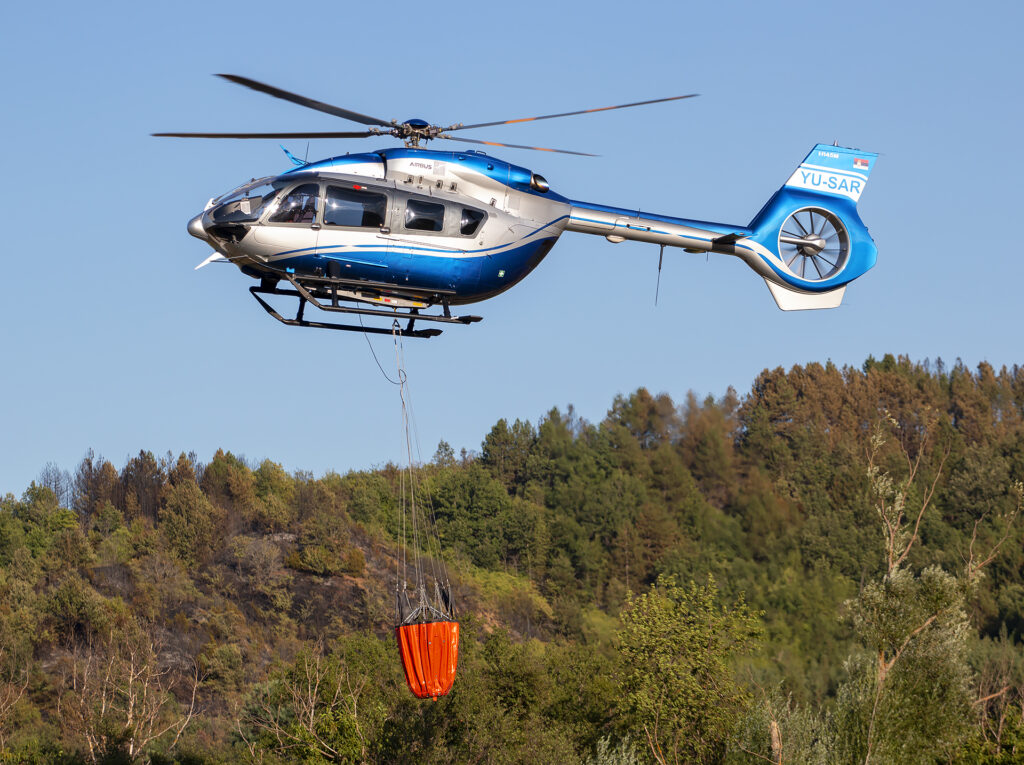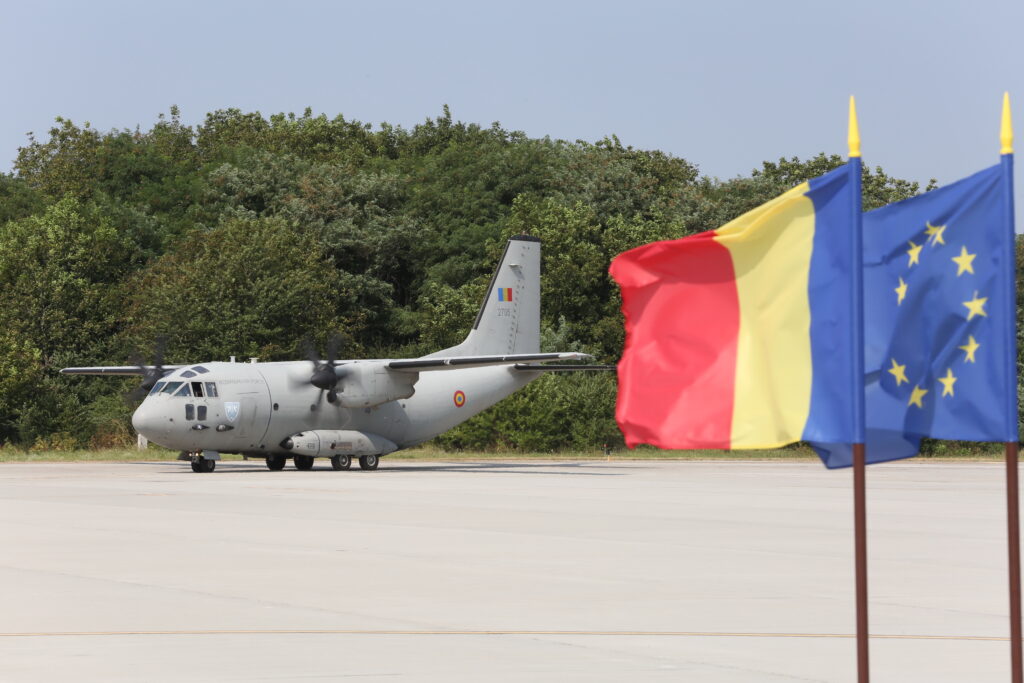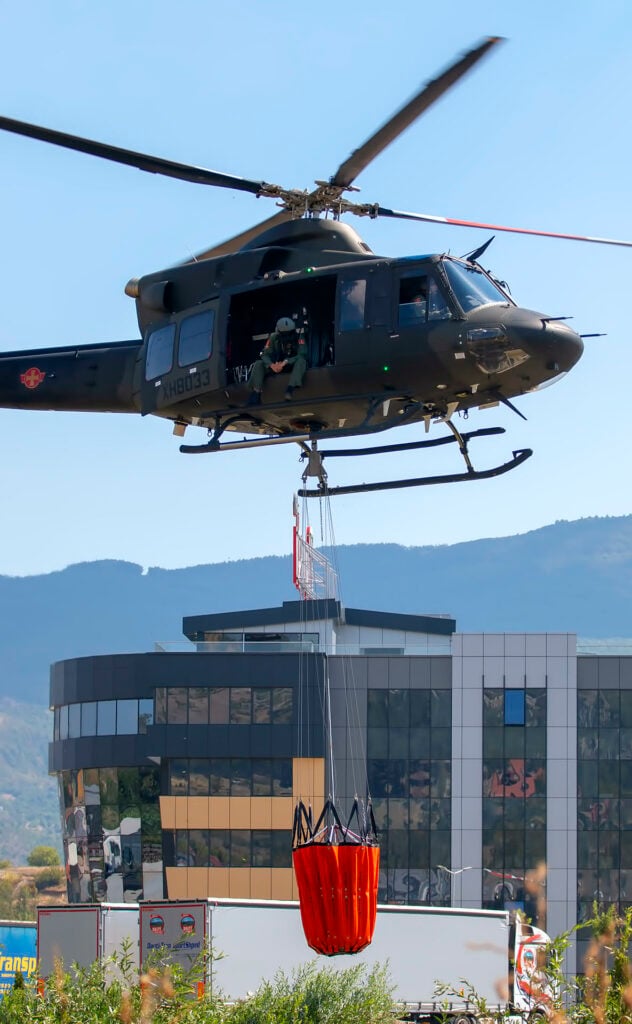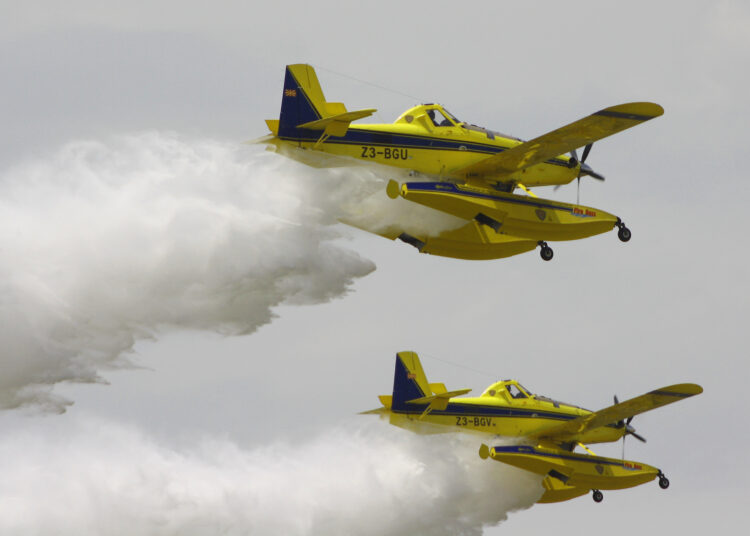The summer of 2021 proved to be one of the worst in decades, with wildfires devastating forests, houses and tourist areas in Turkey, Greece, Albania, Bosnia, Herzegovina, Bulgaria, Croatia, Macedonia, Montenegro and Serbia. These Balkan nations suffered greatly, with hundreds injured and, unfortunately, several deaths during wildfires in July and August 2021. This once again shined a light on the extreme negligence and lack of responsibility Balkan governments' that neglect the adequate funding and support of civil protection departments responsible for aerial firefighting. These government sectors are constantly left with limited budgets insufficient for building, maintaining and providing needed upgrades to systems that would rapidly respond and effectively battle summer wildfires. In such scenarios, the aerial firefighting assets remain the key for prompt and efficient solving of domestic and international wildfire threats before they escalate into national-level disasters.

A significant point in the criticism aimed at the Balkan nation government is the lack of proper funds allocation, which allows the ongoing maintenance of state-owned aerial firefighting assets. This year, as was the case in Macedonia, the absence of proper funds left three highly-capable Air Tractor AT-802A Fire Boss aircraft unserviceable in the middle of the peak summer fire season. Overnight, this decision turned the nation from a proven, decades-long example for self-sustainability in battling wildfires into a government on its knees begging for international aid to assist in providing aerial firefighting assistance. Meanwhile, the country suffered tens of millions of dollars in damages, including forested areas that will take between 30-50 years to return to pre-fire growth.

From National Celebration to a State of Crisis
The Macedonia holiday of "Llinden," which means "The Day of the Republic," is a major national holiday celebrated on August 2 of each year. The holiday commemorates two significant events in Macedonian history: the establishment of the statehood of the Balkan nation, which took place on the same date, and the Ilinden Uprising of 1903 against the Ottoman Empire, the First Anti-fascist Assembly for the national liberation of Macedonia. A 1944 political gathering laid the foundation of the Socialistic Republic of Macedonia within the borders of the now non-existent Yugoslavia during World War II.
This year's events began with nationwide celebrations. They ended with Macedonia entering its worst wildfire crisis since the catastrophic fires in August of 2007. The nation finally recognized the need to activate the Macedonian Air Force's (Makedonsko Voeno Vozduhoplovstvo) three Russian Mi-17 Helicopters and four Mi-8MT helicopters. Even combined with the air force's primary operations, it would not be capable of suppressing wildfires regularly burning in forested areas without the support of state-owned and operated fixed-wing aerial firefighting assets and an international assistance plan when needed. Following the lead of nations like Croatia, Montenegro and Cyprus, that each purchased US-made Air Tractor AT-802 firefighting aircraft after the 2007 wildfires, Macedonia also opted for the extremely capable 800 gallon (3,028 litres) water bomber, buying three float-configured Fire Boss aircraft in March 2009 which went in operation in June 2010.

With its competent FireBoss fleet left unserviceable in the middle of a summer season due to repeated public procurement complications, and only three Mi-8MT/17 helicopters available for firefighting missions, Macedonia this year found itself in a much worse crisis than in 2007. A "déjà vu" moment occurred on August 2 this year when the national celebrations were abruptly cut short as weeks of high temperatures combined with strong winds, and a lightning storm produced a massive wildfire that started on a mountain above Kočani, a small city located 43 miles (70 km) southeast of the capital of Skopje.
The city was encircled by fire from three sides by midnight, engulfing numerous houses along the mountain slope. As panic began to spread among locals via social networks, many implored local authorities to launch the Air Tractor fleet to fight the fires and save Kočani. Faced with enormous public pressure, government officials shocked the nation by admitting that its firefighting planes would remain grounded at the Skopje International Airport for the entire summer because their scheduled maintenance (worth around 400,000 Euro) was not completed. Repeated complications with the public procurement process causing an avalanche of public condemnation and anger.

After much hard work on the ground throughout the night, the Kočani fires were brought under control. However, the morning of August 3 faced Macedonia with the sad and ugly reality that the nation was entering into a more dangerous fire season than they met in 2007, this time without the air support the country was accustomed to. Without the ability to count on its Air Tractor fleet, Macedonia was left to rely on an aerial Russian-made firefighting fleet with the occasional backup of two ageing police helicopters, one which was mainly used for transportation.
The wildfire crisis escalated again on August 3, as the week-long heatwave continued unabated, igniting many wildfires across Macedonia. The fires reached out of control status despite the Air Force helicopter's efforts against the very poorly equipped ground firefighting units. Faced with a worsening crisis, the government in Skopje mobilized the Army to fight the fires, imposing a complete ban on movement in forest areas while at the same time requesting international aid for aerial and ground firefighting assets. Ultimately, declaring a 30-days nationwide state of emergency on August 5.

Macedonian-Serbian Aerial Firefighting Mutual Aid
The first nation to respond to Macedonian appeals for assistance was neighbouring Serbia. After a telephone call between political leaders of both countries on August 2, an order was issued to the Serbian Ministry of Interior (Ministarstvo Unutrašnjih Poslova - MUP) to deploy four helicopters to the neighbouring nation. The contingent of five helicopters, including a lead aircraft, the MUP's newest, an Airbus H145M, carrying Serbian interior minister Aleksandar Vulin departed Belgrade on August 3, arriving at Macedonia's Skopje international airport the same day.
Serbia's contribution to the wildfire fight included a pair of AB-212s, an Airbus H145M, and a SOKO SA-342 Gazelle, all initially assigned to a Serbian police aviation unit at Belgrade's Nikola Tesla international airport.
The Serbian contingent of helicopters began their operations on August 4, flying in formations led by the Macedonian Air Force's Mi-18/17s equipped with SEI Industries Bambi Bucket systems capable of dropping 660 gallons (2,500 litres.) The Serbian contingent of helicopters carried smaller capacity buckets appropriate to their aircraft size; the AB-212 carried a 300 gallon (1,200 litres) bucket. The H145M worked with a 200 gallon (800 litres) Bambi Bucket, while the Gazelle helicopter was used for aerial assessment, guidance, liaison and transport roles during the operation.

The first day of operations saw Serbia's contingent of helicopters extinguishing wildfires near the village of Drenok, in the vicinity of the famous Kokino megalithic observatory, some 24 miles (40 km) north-east of the Skopje airport. The crews dropped more than 5800 gallons (22,000 litres) of water on the fire during this operation. The following three days, the helicopters were redirected to the far east of Macedonia, where devastating fires were raging in the pine forests between the cities of Berovo and Pehčevo, near the Macedonian-Bulgarian border, 65 miles (105 km) southeast of Skopje airport.
During the first two days of operations, and wildfires in different locations, refuelling the helicopters provided a challenge due to having to cover a considerable distance to refuel. Pilots were challenged regularly to maintain good weight and balance, match the fuel loads to ensure effective firefighting operations, and ensure the aircraft could still make the more extensive return trip for refuelling.
Serbia's crews continued their efforts on August 6, focusing on saving the village of Budinarci, dropping over 10,000 gallons (38,000 litres) of water to extinguish that blaze. Establishing a forward fueling base also improved effectiveness after the Macedonian government released 15,000 gallons of fuel in the firefighting operation to the forward operating base, allowing the aircraft to hot fuel thanks to the addition of fire apparatus on standby at the forward command.
Serbia's MUP helicopters sent to Macedonia marked the second firefighting operation for Serbian Police helicopters outside national borders. Two AB-212s and a Gazelle helicopter were also sent to neighbouring Bosnia and Herzegovina on July 31, 2021, assisting in the aerial firefighting effort to fight the Stolac mountain wildfire near the city of Višegrad in Republika Srpska, one of the two entities of Bosnia and Herzegovina.
Helicopter Unit Commander Nenad Nedić said that Macedonia was a challenging mission that flew between 7 and 9 hours a day. "We flew a lot, but the water collecting points were often far away from the wildfires, and so the quantity of dropped water is far lower than it should be," Nedić explained, adding that 92 flight hours were flown by MUP helicopters that managed to attack the wildfires with between 47,550 gallons (180,000 litres) and 50,100 gallons (190,000 litres) of water during the deployment.
Serbia's mission to Macedonia ended on August 7 when the helicopters returned to Belgrade before being quickly returned to international aid service. Two AB-212s and one H145M were sent out the following morning to the Hellenic Air Force base of Tanagra to take part in the international efforts to extinguish the catastrophic wildfires at the Greek island Evia.

Romanian Firefighting Spartan on the Macedonian Skies
By the time Serbians left Macedonia, the EU Civil Protection Mechanism (EUCPM) was already mobilized - consisting of a team of 46 firefighters and 16 firefighting vehicles that arrived in Macedonia from Slovenia and were deployed around the city of Berovo on August 5. At the same time, 25 Bulgarian firefighters organized in four groups with two firefighting trucks and began fighting wildfires around Umlena, Robovo, and Mitrašinci, all located near the city of Pehčevo.
With devastating wildfires raging across the country, Macedonia's aerial fleet was still severely depleted. This led the government of Macedonia to request further aerial firefighting assistance through EUCPM. Romania immediately deployed two Romanian Air Force (Forțele Aeriene Române - FAR) transport planes: an Alenia C-27J Spartan of the 902nd Operational Air Transport and Aerofotogrametria Squadron. This aircraft is configured to carry up to six 1,000 litre droppable cardboard containers. A C-130B Hercules (6166) of the 901st Tactical Air Transport Squadron was sent to Skopje to provide logistical support.
The Romanian transporters left their home base - in Bucharest at Otopeni airport on August 7, arriving on-site with a team of 15 FAR servicemen to support the mission. The Spartan's first firefighting mission was executed around the city of Delčevo the same day. The Romanian operations continued with the C-27J over the following days, attacking wildfires in Divlje, a village near Skopje international airport, in critical areas in southeast Macedonia and along the border with Bulgaria, as well as in the Raovikj village in the vicinity of Skopje.
Romanian Spartans are the first global users of Alenia's Caylym Guardian firefighting system, allowing an in-flight drop of up to six cardboard biodegradable containers that ground firefighters can also recover. The containers can be installed on both C-27J and C-130 transporters without any proprietary equipment or modification and launched from altitudes of 1500 feet (460 meters), significantly increasing mission safety and even allowing night deployment.
Romanians carried out 18 aerial firefighting missions in Macedonia between August 7 and 12, in which some 100 containers of water were dropped during 15 flight hours accumulated by C-27J crews fighting fires.
The demanding deployment to Macedonia marked the second international firefighting mission for Romanian FAR aircraft, the first one taking place in July of 2018 in Greece. Romania's C-27J aircraft also extinguished two domestic wildfires during 2017, one in Șvinița, in Mehedinți county, the second in the area of Buceș, Vulcan Mountains, at the border between Alba and Hunedoara counties.
The Macedonian deployment of Romania's FAR aircraft ended on August 13 with a modest ceremony held at Bucharest-Otopeni airport where honorary medals were awarded to mission members, the 90th Airlift Base, and the FAR itself.

The Montenegrins for the End
In addition to assistance provided by Serbia and Romania, Montenegro's Armed Forces (Vojske Crne Gore - VCG) also dispatched their Bell 412EPI helicopter for mutual aid, arriving on August 11, under engagement arranged within the Euro-Atlantic Disaster Response Coordination Centre (EADRCC), NATO's principal civil emergency response mechanism in the Euro-Atlantic area.
This was the first-ever international firefighting mission for Montenegro's VCG helicopter that was deployed through August 18. In the seven days of active firefighting in Macedonia, the Montenegrin aircraft used a 400 gallon (1,600 litres) Bambi Bucket, accumulating 20 flight hours and dropping over 21,000 gallons (80,000 litres) of water. The Bell 412EPI worked in tandem with a Macedonian Air Force Mi-8MT/17 helicopters that accumulated over 80 flights and made over 300 drops delivering more than 171,000 gallons (650,000 litres) of water on wildfires across Macedonia.
The Macedonian-Montenegrin helicopter duo extensively worked together on taming down and extinguishing wildfires in Raovikj, Bukovikj, Čajlane and Grčec villages in the vicinity of Skopje, then in the Kavadarci and Demir Kapija areas where water was collected from the Mokliško Lake for follow-on extinguishing Vešje and Barovo wildfires, as well as in Gorno Melničani village where water was collected from the nearby Lake Debar. In extinguishing Skopje wildfires, 50 Macedonian special police forces assisted and were supported by seven French wildfire experts equipped with drones carrying unique thermal cameras allowing detection of hotspots hidden by the smoke rising from the burning forests.
The Macedonian wildfire crisis ended with long-awaited rains finally extinguishing most wildfires during mid-August. In total, 106 large wildfires engulfed over 25,000 acres (10,000 hectares) of forests in Macedonia in the first half of August. The damage, estimated to be over 10 million euros, is a considerable loss when considering the cost of 2021 servicing and ADS-B avionics upgrades of the Macedonian Air Tractor AT-802A Fire Boss fleet that was not completed that would have only cost the nation around 400,000 Euro. Only 4% of the Balkan country's damage this year was due to the irresponsible grounding of the nation's fire-bombing fleet in the middle of a peak summer fire season that was a gamble that did not pay off. With their combined, nearly 2500 gallon (9,300 litres) water/foam/retardant capacity, these aircraft would have almost certainly quashed any need for international aid to be requested by Macedonia as it has over their last ten years of operation.
The 2021 wildfire season was a tragic, painful, and expensive lesson for Macedonia. If the nation's politicians learned a lesson with this season's loss, it would be evident in 2022.






